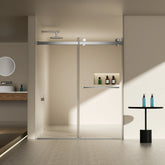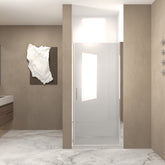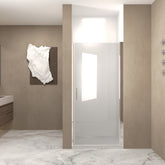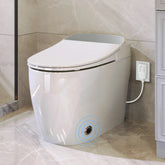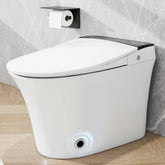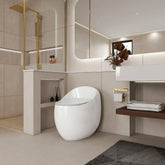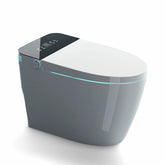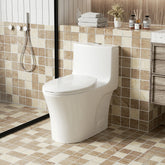The Future of Bathroom Tech: What’s Next After Smart Toilets
Introduction
Over the past decade, smart toilets have completely redefined the bathroom experience. What used to be a purely functional space is now part of the broader smart home ecosystem—equipped with heated seats, automatic lids, built-in bidets, and even self-cleaning functions. As someone who appreciates both innovation and comfort, I’ve been amazed at how far bathroom tech has come.
But it doesn’t stop there. With smart toilets now mainstream in many modern homes, I can’t help but wonder: what’s next? What new technologies will continue this wave of transformation and push bathroom innovation even further?
In this article, I’ll dive into the future of bathroom technology—from AI-powered wellness tools and immersive spa-like setups to sustainable systems designed to conserve water and energy. If you’re curious about the next generation of smart bathroom devices, or you're considering your next home upgrade, this journey into what’s coming after smart toilets is for you.

1. From Smart Toilets to Smarter Ecosystems
Smart toilets were just the beginning. As someone who has gradually upgraded different parts of my home, I’ve seen how bathroom tech is quickly evolving from isolated devices into fully integrated ecosystems. The future isn’t just about a high-tech toilet—it’s about creating a connected, intelligent environment where every feature works in harmony.
Imagine walking into your bathroom and everything adjusts automatically: the lights dim to your preferred morning setting, the heated floor turns on, your favorite playlist starts playing softly, and your mirror displays the weather forecast—all triggered by a voice command or even facial recognition. This kind of seamless experience is made possible through integration with smart home platforms like Alexa, Google Home, or Apple HomeKit.
What excites me most is the rise of unified control panels. Rather than juggling multiple apps for lighting, ventilation, mirrors, or toilets, a single smart interface—on a wall-mounted touch screen or smartphone—can manage it all. This means I can personalize settings for different users in the house, schedule cleaning cycles, or adjust water temperature and ambient lighting with just a tap or a command.
As AI continues to improve, these systems will also learn from our daily routines. Whether it’s setting the ideal temperature for your morning shower or dimming the lights before bed, the smart bathroom of tomorrow will anticipate our needs before we even ask. It's not just convenient—it’s transformational.
2. AI and Predictive Maintenance
One of the most impressive shifts I’ve noticed in bathroom tech is how artificial intelligence is being used for more than just convenience—it's now actively helping us maintain our homes and monitor our health. In my own experience with smart devices, I’ve come to appreciate how much easier life becomes when technology anticipates problems before they arise.
Advanced smart sensors are already making this possible. These systems can detect small leaks in plumbing or low levels of essential supplies like toilet paper or soap, alerting me before things become an inconvenience—or worse, an expensive repair. It’s a form of predictive maintenance that takes the guesswork out of home upkeep.
What really excites me, though, is how AI is learning from usage patterns. Over time, it can adjust water pressure, flushing strength, or energy consumption based on when and how I use my bathroom. This not only improves efficiency but also contributes to a more eco-friendly lifestyle, something that’s becoming increasingly important to me.
And then there’s the health-tech integration. We’re starting to see smart toilets and mirrors with embedded health-tracking features. Some can analyze urine to monitor hydration levels or detect early signs of illness. Others might track heart rate, skin condition, or even stress levels. While this might sound futuristic, it’s quickly becoming a reality—and as someone who values proactive wellness, I find this development both fascinating and incredibly useful.
AI in the bathroom isn’t just about making things smarter—it’s about making our lives healthier, more efficient, and more connected than ever before.

3. Immersive Wellness Experiences
As someone who sees the bathroom as more than just a functional space, I’ve been thrilled to see how technology is transforming it into a true sanctuary. The future of bathroom tech isn’t just smart—it’s immersive, wellness-focused, and designed to help us recharge both physically and mentally.
Today’s innovations are blurring the lines between bathroom and spa. I’ve tested setups that include aromatherapy diffusers, chromotherapy lighting, and calming soundscapes that can be customized for different moods. Whether I want an energizing experience in the morning or a calming ritual before bed, everything adjusts at the push of a button—or better yet, automatically based on the time of day.
Smart showers are another favorite of mine. They come equipped with water-saving presets and personalized profiles that remember preferred temperature, pressure, and duration. Some even sync with music and lighting for a fully mood-based experience. It’s not just about luxury—it’s about creating intentional moments of peace in a busy day.
And the little things matter, too. Heated floors make cold mornings feel more bearable. Fog-free mirrors with built-in displays let me check the news or weather while getting ready. These seemingly small upgrades come together to create a holistic experience that prioritizes wellness, comfort, and smart living.
For me, the shift toward immersive wellness in the bathroom represents something bigger: a move toward homes that support our health and happiness on a deeper level. And with each new innovation, that vision is becoming more attainable.
4. Eco-Friendly and Sustainable Tech
As much as I love smart features and futuristic design, sustainability is just as important to me—if not more. That’s why I’ve been especially excited about how bathroom technology is becoming more eco-friendly. Today’s innovations are not just about luxury or convenience—they’re also about reducing our environmental impact.
One of the most promising developments I’ve explored is the use of greywater recycling systems. These systems capture water from sinks or showers, filter it, and reuse it for flushing toilets or watering plants. It’s a simple yet powerful way to conserve resources, especially in areas where water scarcity is a growing concern. I’ve seen firsthand how this technology can significantly cut household water consumption.
Smart faucets and toilets are also making a real difference. The latest models use motion sensors and AI to adjust water flow and optimize flushing based on the type of waste. I’ve noticed how these features reduce unnecessary water usage without compromising performance—an ideal balance between sustainability and functionality.
Another exciting step forward is the integration of solar-powered bathroom components. From lighting systems to ventilation fans and even self-charging mirror displays, solar energy is helping make the bathroom more energy-efficient. For someone like me who values green living, the ability to reduce electricity consumption while still enjoying modern tech is a huge win.
Eco-friendly bathroom tech proves that sustainability doesn’t mean sacrificing comfort. In fact, it’s quite the opposite—it’s about using intelligent design and smart technology to create a better experience for both people and the planet.
5. Privacy, Data Security & Ethics
As much as I’m fascinated by the possibilities of smart bathroom technology—especially features like health tracking and predictive maintenance—I’ve also found myself thinking more about the privacy and ethical implications. When our toilets, mirrors, and showers start collecting personal data, the question becomes: how do we stay in control?
Health-tracking smart devices are a double-edged sword. On one hand, it’s amazing that a toilet could analyze hydration levels or a mirror could monitor heart rate trends. On the other hand, this means extremely personal information is being collected—often automatically. I’ve asked myself: where is that data going, and who has access to it?
That’s why I believe secure cloud connections and strong data encryption must be standard in all smart bathroom ecosystems. Devices should store usage data responsibly and give users complete control over what’s collected, what’s shared, and what’s deleted. I want the benefits of personalization without having to worry about my private health data ending up in the wrong hands.
It really comes down to balancing innovation with trust. I think the companies that will lead the next generation of bathroom tech are the ones that prioritize user transparency and ethical design. Whether it’s adding opt-in settings, anonymizing data, or offering offline modes, we deserve to enjoy smart features without compromising privacy.
In the end, I believe bathroom technology should empower us—not surveil us. If we can strike that balance, then the future of bathroom tech will not only be smart and sustainable, but also safe and ethical.
6. The Commercial and Hospitality Impact
While I often focus on smart bathroom technology from a homeowner’s perspective, I’ve also seen how these innovations are making a big impact in the commercial and hospitality industries. In fact, some of the most impressive bathroom tech I’ve experienced has been in hotels, upscale restaurants, and modern airports—places where comfort, efficiency, and image all matter.
Smart hotel bathrooms are quickly becoming a key luxury selling point. Features like heated toilet seats, touchless faucets, chromotherapy lighting, and digital shower systems elevate the guest experience in a way that truly sets high-end properties apart. As a frequent traveler, I’ve come to expect these amenities in modern hotels—and I know I’m not alone.
On the commercial side, restrooms equipped with occupancy sensors, automated cleaning systems, and air-quality monitors are changing the game. I’ve visited office buildings and public spaces where restrooms notify cleaning staff when they’ve been heavily used or alert users when stalls become available. These innovations not only improve hygiene but also enhance overall facility management and user satisfaction.
What’s especially exciting is how B2B adoption is expanding. Real estate developers, resorts, and airport operators are starting to see smart bathroom technology as an investment, not just a novelty. They’re installing water-saving systems, energy-efficient lighting, and voice-activated controls to reduce costs, attract tenants or guests, and promote a forward-thinking image.
From my perspective, this commercial evolution proves that bathroom tech is no longer just a personal upgrade—it’s a competitive advantage. Whether it’s enhancing guest experiences or streamlining operations, smart bathroom innovations are reshaping expectations across industries.
7. Challenges and Considerations
As much as I’m excited about the future of bathroom technology, I’ve also come to realize that the road ahead isn’t without its bumps. Like any evolving innovation, smart bathroom ecosystems face real-world challenges—many of which I’ve encountered or heard about from others considering the switch.
One of the biggest hurdles is the cost barrier to adoption. High-end smart toilets, digital showers, and AI-powered mirrors don’t come cheap. For many people, the initial investment feels hard to justify, especially if the benefits aren’t immediately visible. Even I hesitated before installing my first smart bathroom device. It’s a long-term commitment that not everyone is ready to make.
Then there’s the issue of retrofitting older homes. I live in a house that wasn’t exactly built with tech integration in mind. Trying to add voice-controlled lighting or upgrade plumbing to accommodate a greywater recycling system can be complicated—and sometimes costly. Retrofitting is possible, but it takes planning, time, and sometimes creative problem-solving.
I’ve also noticed a surprising amount of consumer resistance to over-automation. Not everyone is comfortable with voice assistants in private spaces like the bathroom. Some people worry about losing control, or they simply prefer manual interactions over digital ones. And let’s be honest—no one wants to deal with a smart toilet that won’t flush because of a software glitch.
That’s why I believe consumer education is crucial. People need to understand not just what the technology does, but how it works, how it’s maintained, and how it respects their privacy. Clear guidance and thoughtful design can go a long way in building trust and enthusiasm.
Ultimately, the challenges are real—but they’re not insurmountable. With the right approach, the bathroom tech industry can continue to grow in a way that’s inclusive, practical, and truly beneficial for everyday users like me.
8. What to Expect in the Next 5–10 Years
As I look ahead, I can’t help but feel excited about where bathroom technology is heading. The past few years have already shown us what’s possible with smart toilets and connected devices—but the next 5 to 10 years promise an even bigger leap. We’re entering an era where our bathrooms won’t just be smarter—they’ll be intuitive, invisible, and deeply integrated into our lifestyles.
First, I expect to see major advancements in predictive AI and full IoT integration. Bathroom devices will no longer just respond to commands—they’ll anticipate them. My toilet might flush based on subtle behavioral cues, or my mirror could automatically adjust lighting based on time, weather, or even my mood. Everything will sync effortlessly with my broader smart home system, creating a truly connected experience from bedroom to bathroom.
We’re also moving toward what I call “invisible tech”—sleek, minimalist designs that don’t look high-tech at all, but are powered by incredibly advanced systems underneath. Picture mirrors that double as touchscreens, faucets without visible controls, or walls that change temperature or color silently and intelligently. I love how this approach keeps the space elegant while maximizing functionality.
More than anything, I see the bathroom becoming a central hub for wellness, sustainability, and convenience. Whether it’s through smart showers that help reduce water waste, toilets that monitor health, or systems that make everyday routines easier and more personalized, the bathroom of the future will be about more than just hygiene—it will support a healthier, more mindful lifestyle.
For me, this vision is more than a trend—it’s the natural evolution of how we live. And I can’t wait to see (and experience) how far this next wave of innovation will go.
9. Conclusion
Reflecting on all the innovations beyond smart toilets, it’s clear that bathroom technology is undergoing a remarkable transformation. From AI-driven predictive maintenance and eco-friendly water systems to immersive wellness experiences and seamless smart home integration, the future of bathroom tech is more exciting—and more personal—than ever before.
What once served as a purely functional space is now evolving into a personal sanctuary, where comfort, sustainability, and intelligent design intersect. I’ve seen firsthand how these innovations can elevate everyday routines and create a sense of calm, luxury, and even improved well-being.
Whether you’re a tech enthusiast like me, a homeowner planning your next renovation, or a business exploring the commercial potential of bathroom innovation, there’s no better time to stay informed. These trends are no longer just concepts—they’re becoming accessible, adaptable, and incredibly impactful.
So, if you’ve ever wondered what’s next after smart toilets, I encourage you to keep an eye on the latest developments—or better yet, start planning your next upgrade. The smart, sustainable, and wellness-focused bathroom of the future isn’t just coming—it’s already taking shape.
Featured Products
AISU Smart Bidet Toilet with Remote Control.Raised Tankless Toilet with LED Display
- $522.68
- $522.68
- Unit price
- / per
AISU One Piece Heated Seat Smart Toilet, White
- $364.79
- $364.79
- Unit price
- / per
AISU Smart Toilet with Foot Sensor Flush, Blue Night Light, White
- $366.72
- $366.72
- Unit price
- / per
AISU One-Piece 1.28 GPF Single Flush Egg Shape Toilet
- from $481.74
- from $481.74
- Unit price
- / per
-
Glossy White
-
Glossy Black
AISU Smart Toilet with Heated Bidet Seat, Portable toilet with bidet built in AUTO Open&Close, AUTO Dual Flush, Bidet toilet with Dryer and Warm Water, White
- $642.24
- $642.24
- Unit price
- / per
AISU 1.28 GPF Tornado Flush Two-piece Toilet for bathrooms, Gloss White
- $236.91
- $236.91
- Unit price
- / per
AISU 1.1/1.6 GPF Tornado Flush One-Piece Toilet Elongated, Siphonic S-trap 12", Soft Closing Seat, Button on Tank top, Powerful Dual Flush MAP 1000g, Comfort Chair Seat ADA Height 17", Glossy White
- $372.43
- $372.43
- Unit price
- / per
